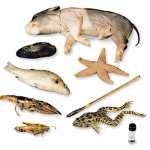Zoology
|
17 november 2013 01:35:18 |
| Simultaneous subchronic exposure to selenium and diazinon as possible risk factor for osteoporosis in adult male rats (Acta Veterinaria Scandinavica) |
|
Tweet Background:
Osteoporosis and its main health outcome, fragility fractures, are large and escalating health problems. Skeletal damage may be the critical result of low-level prolonged exposure to several xenobiotics in the general population, but the mechanisms of their adverse effects are not clearly understood. The current study was aimed to investigate the possible ability of simultaneous subchronic peroral administration of selenium (Se) and diazinon (DZN) to induce changes in bone of adult male rats.In our study, twenty 1-month-old male Wistar rats were randomly divided into two experimental groups. In the first group, young males were exposed to 5 mg Na2SeO3/L and 40 mg of DZN/L in drinking water, for 90 days. Ten 1-month-old males without Se and DZN intoxication served as a control group. At the end of the experiment, macroscopic and microscopic structures of the femurs were analysed using analytical scales, sliding instrument, and polarized light microscopy.
Results:
The body weight, femoral length and cortical bone thickness were significantly decreased in rats simultaneously exposed to Se and DZN (P < 0.05). These rats also displayed different microstructure in the middle part of the compact bone where vascular canals expanded into central area of substantia compacta. The canals occurred only near endosteal surfaces in rats from the control group. Additionally, a smaller number of primary and secondary osteons, as well as a few resorption lacunae were observed near endosteal surfaces in rats simultaneously administered to Se and DZN. The resorption lacunae as typical structures of bone resorption manifestation are connected with an early stage of osteoporosis. Histomorphometric analysis revealed that area, perimeter, maximum and minimum diameters of primary osteons` vascular canals were significantly increased (P < 0.05) in the Se-DZN-exposed rats. On the other hand, all measured variables of Haversian canals and secondary osteons were considerable reduced (P < 0.05) in these rats.
Conclusions:
Simultaneous subchronic peroral exposure to Se and DZN induces changes in macroscopic and microscopic structures of the femurs in adult male rats, and also it can be considered as possible risk factor for osteoporosis. The current study contributes to the knowledge on damaging impact of several xenobiotics on the bone. |
| 92 viewsCategory: Medicine, Zoology |
 Causes of mortality and pathological lesions observed post-mortem in red squirrels (Sciurus vulgaris) in Great Britain (BMC Veterinary Research) Causes of mortality and pathological lesions observed post-mortem in red squirrels (Sciurus vulgaris) in Great Britain (BMC Veterinary Research)Bovine brucellosis trends in Malaysia between 2000 and 2008 (BMC Veterinary Research) 
|
| blog comments powered by Disqus |
MyJournals.org
The latest issues of all your favorite science journals on one page
The latest issues of all your favorite science journals on one page



